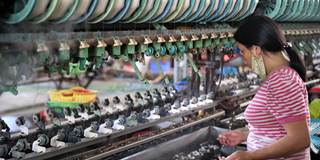After decades of labor-intensive production by legions of low-paid workers in the Global South, technology is changing how the world’s clothing is designed, produced, packaged, and sold. If developing economies are to remain competitive during this shift, their leaders must change how they think about the industry.
COLOMBO – For many years, discussion of the global garment industry has been dominated by the following question: Where were your clothes made, and by whom? But today, there is a more relevant question: How were your clothes made, and by what?
What you wear is going high-tech, whether you know it or not. After decades of labor-intensive production by workers in the Global South, artificial intelligence (AI) and robotics are replacing humans on the factory floor. But, while these shifts will bring new benefits to consumers – such as faster delivery and custom clothing – they will come with costs. Changes to the garment industry’s business model are threatening the livelihoods of millions of people in low- and middle-income countries, and how these economies adapt will have far-reaching implications.
Today, more than half of the world’s textile exports, and about 70% of its ready-made apparel exports, come from developing economies. In Asia, some 43 million people are employed in the garment, textile, and footwear industries, with women accounting for three-quarters of the workforce. From China to Bangladesh, textile and apparel manufacturing has facilitated female empowerment and lifted entire generations out of poverty. Simply put, the end of these jobs would be devastating.

COLOMBO – For many years, discussion of the global garment industry has been dominated by the following question: Where were your clothes made, and by whom? But today, there is a more relevant question: How were your clothes made, and by what?
What you wear is going high-tech, whether you know it or not. After decades of labor-intensive production by workers in the Global South, artificial intelligence (AI) and robotics are replacing humans on the factory floor. But, while these shifts will bring new benefits to consumers – such as faster delivery and custom clothing – they will come with costs. Changes to the garment industry’s business model are threatening the livelihoods of millions of people in low- and middle-income countries, and how these economies adapt will have far-reaching implications.
Today, more than half of the world’s textile exports, and about 70% of its ready-made apparel exports, come from developing economies. In Asia, some 43 million people are employed in the garment, textile, and footwear industries, with women accounting for three-quarters of the workforce. From China to Bangladesh, textile and apparel manufacturing has facilitated female empowerment and lifted entire generations out of poverty. Simply put, the end of these jobs would be devastating.